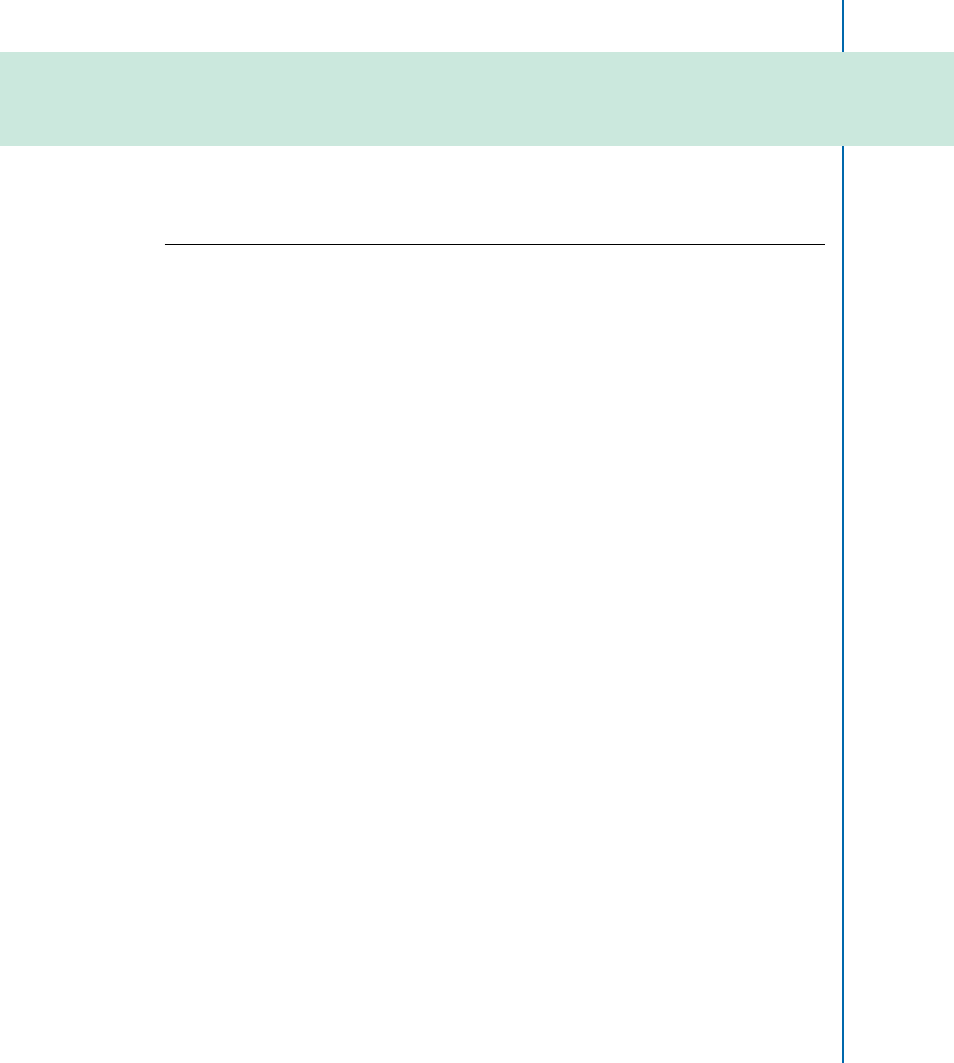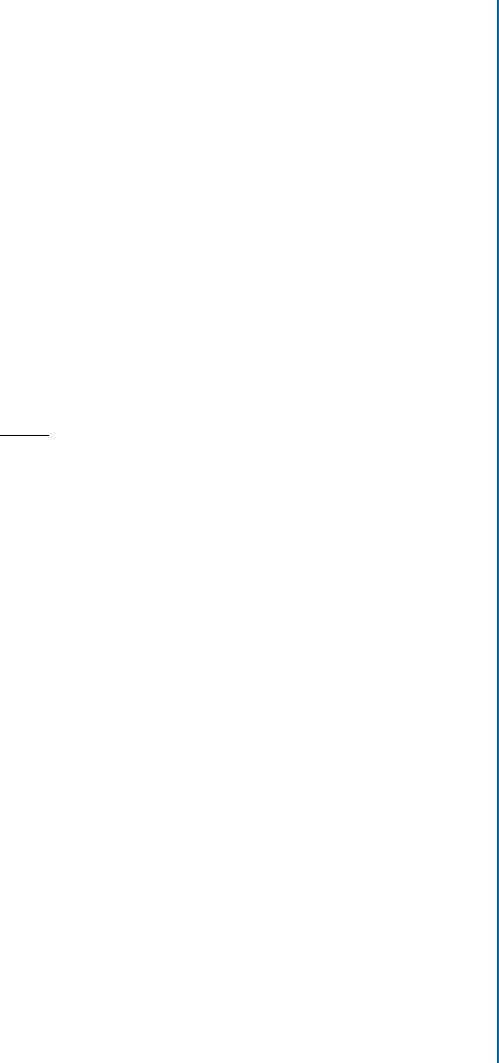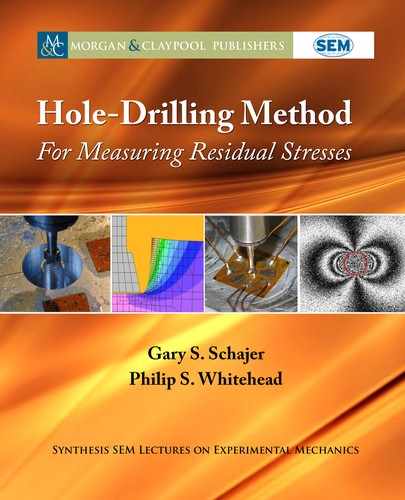
87
C H A P T E R 5
Stress Computations
“e residual stresses originally existing at the hole location are evaluated from the strains
relieved by hole-drilling using mathematical relations based on linear elasticity theory.”
ASTM E837 (2013) “Standard Test Method for Determining Residual Stresses by the
Hole-Drilling Strain-Gage Method.”
5.1 INTRODUCTION
After the hole has been drilled and the associated surface deformations measured, the remaining
major procedural step is to compute the indicated residual stresses. Even in the simplest case
where a single average local residual stress value is desired, the calculation requires some sophis-
tication. is need occurs because hole-drilling involves partial strain relief only, so the specific
fraction of the strain relief needs to be known. is is achieved using theoretical or experimental
calibrations. For more detailed measurements, where the within-depth profile of the residual
stresses is the objective, a much more complex calculation procedure becomes necessary.
is chapter describes some practical methods for computing hole-drilling residual
stresses from measured surface deformation data. It starts from the basic case where the residual
stresses are uniform through the depth of the specimen material, and goes on to the much more
challenging case of evaluation of within-depth residual stress profiles. e given details refer
to computation procedures suitable for use with the strain data measured using strain gauges.
Chapter 7 describes analogous procedures specialized for use with full-field deformation data
from optical methods such as ESPI, Moiré and DIC.
5.2 UNIFORM RESIDUAL STRESSES
e Hole-Drilling Method measures the residual stresses that originally existed within the ma-
terial cut from the drilled hole. is material lies next to the specimen surface, where plane-stress
conditions occur. Consequently, the out-of-plane stresses are very small and may be considered
negligible. Hole drilling measurements therefore focus on the three in-plane stresses
x
,
y
and
xy
.
“Uniform” residual stresses are said to occur when the stresses that originally existed within
the material cut from the hole were of similar size throughout the depth and diameter of the
hole. In this case, the set of three in-plane stress values fully describe the local residual stress

88 5. STRESS COMPUTATIONS
state. Evaluation of these three stresses requires three independent measurements, for example,
provided by a three-element strain gauge rosette similar to that shown in Figure 5.1.
y
x
θ
Figure 5.1: Typical hole-drilling strain gauge rosette (reproduced by permission of Micro-
Measurements, a Vishay Precision Group brand).
Commercial hole-drilling rosettes are universally of the 45
ı
rectangular style because this
arrangement simplifies the associated stress evaluations. e greatest measurement accuracy of
the in-plane strain state is achieved when the gauges 1 and 3 in Figure 5.1 are aligned with
the principal strain directions (same as principal stress directions in an isotropic material). us,
when installing a 45
ı
rosette, it is preferable, although not essential, to align it with the principal
stress directions, if they are known.
It is common to label the two rectangular strain gauges of a 45
ı
rectangular rosette as the
x and y axes, as shown in Figure 5.1. In this arrangement, gauge 1 aligns with the x axis. For an
isotropic material whose boundaries are far from the hole location, the strain "./ measured by
a strain gauge aligned at angle counter-clockwise from the x direction follows a trigonometric
relationship:
./ D
x
C
y
A C
x
y
B cos 2 C
xy
2B sin 2; (5.1)
where A and B are calibration constants whose numerical values depend on the diameter and
depth of the drilled hole and the elastic properties of the specimen material. In practice, these
calibration constants are determined either experimentally or numerically.
Equation (5.1) also applies to the strains observed in the Ring-Core Method. For the
case where the ring-core is cut to a great depth in a uniformly stressed material, the cutting of
the ring-core fully relieves the residual stresses and the calibration constants A and B can be
determined by application of Hooke’s Law to be
A D
1
4E
B D
1 C
4E
: (5.2)

5.2. UNIFORM RESIDUAL STRESSES 89
e leading minus signs occur because the strain measurements are made during material
unloading. Equations (5.2) show that the constants A and B are material dependent, with an
inverse proportionality to Young’s modulus, E. e same inverse proportionality with Young’s
modulus occurs with hole-drilling. However, the Hole-Drilling Method differs importantly
from the Ring-Core Method in that the strain measurement locations are remote from the as-
sociated residual stress locations. is aspect of the method causes the constants A and B to
have greatly different numerical values and for the relationships with Poisson’s ratio to deviate
from those in Equations (5.2). e classical Kirsch analytical solution for the stresses and strains
around a hole in a stressed material indicates a .1 C / influence on the hole-drilling constant
A and a much weaker influence of Poisson’s ratio on the hole-drilling constant B. e latter
effect is so small that it may reasonably be ignored for Poisson’s ratios within the narrow range
found in engineering materials. With these observations in mind, it is convenient to express
the hole-drilling calibration constants in dimensionless form. is generalizes their application
beyond the specific material for which they were originally derived to any linear elastic material
obeying Hooke’s Law.
Na D
2AE
1 C
N
b D 2BE (5.3)
where the superscript bar notation is an historical remnant from previous practice where the
calibration constants were sometimes evaluated by considering the strain at the center point of
each strain gauge. is was only a modestly accurate approach because the strain field within
the strain gauge boundaries is highly nonlinear, causing the center strain to deviate significantly
from the overall average strain. e superscript bar notation was introduced to indicate that
these calibration constants are determined from consideration of the whole strain gauge area.
Average strain can be computed from the double integral of the pointwise strain over
the length and width of the strain gauge. However, it happens that the integral of strain is
displacement. us, the average strain can be more compactly found from the single integral
of relative end displacements in the direction of the gauge conductors across the strain gauge
width. is is a particularly convenient approach when working with the results of finite-element
calculations because these results naturally appear in terms of displacements. e redundant
further steps of differentiating those displacements to produce strains and then integrating the
results back to displacements can entirely be avoided.
In terms of the dimensionless calibration constants Na and
N
b, Equation (5.1) becomes
"./ D P Na.1 C /=E C Q
N
b cos 2=E C T
N
b sin 2=E; (5.4)
where, for the convenience of the subsequent computation procedures, the residual stresses have
been expressed in combined form as
P D
x
C
y
=2; Q D
x
y
=2; T D
xy
: (5.5)

90 5. STRESS COMPUTATIONS
Stress P is the isotropic (direction independent) component of the in-plane stresses. It is
the 2-D version of a hydrostatic (pressure type) stress. Stresses Q and T are deviatoric (shear
type) stresses, respectively, the shear stresses in the 45
ı
and the x-y directions.
e strain gauges in a standard hole-drilling rosette are aligned at angles D 0
ı
; 135
ı
and
270
ı
. Substituting these values into Equation (5.4) gives
"
1
D P Na.1 C /=E C Q
N
b=E
"
2
D P Na.1 C /=E T
N
b=E
"
3
D P Na.1 C /=E Q
N
b=E:
(5.6)
When inverted to allow evaluation of the residual stresses from the measured strains,
Equations (5.6) become
P D
E
Na.1 C /
p Q D
E
N
b
q T D
E
N
b
t; (5.7)
where the combined strains p, q, and t are
p D
.
"
1
C "
3
/
=2 q D
.
"
1
"
3
/
=2 t D
.
"
1
C "
3
2"
2
/
=2: (5.8)
ese strains are directly analogous to the corresponding stresses P , Q and T . Strain p
is the isotropic (direction independent) component of the in-plane strain. Strains q and t are
deviatoric (shear type) strains, respectively, the shear strains in the 45
ı
and the x-y directions.
Finally, the Cartesian stresses and the principal stresses and directions can be determined
from P , Q, and T using
x
D .P C Q/
y
D .P Q/
xy
D T (5.9)
max
;
min
D P ˙
p
Q
2
C T
2
(5.10)
and where the direction of the more tensile (or less compressive) principal stress is
ˇ D 0:5
arctan.T = Q/; (5.11)
where ˇ is measured clockwise from the direction of gauge 1 (x-direction) in Figure 5.1. e
second principal stress (more compressive or less tensile) is in the perpendicular direction, that is,
at angle ˇ measured clockwise from gauge 3 (y-direction) in Figure 5.1 (either the Cy or y di-
rections can be used). Use of the two-argument arctangent function places ˇ in the correct quad-
rant, for example ATAN2(-Q,-T) in Excel, atan2(-Q,-T) in C and Matlab and ATAN2(-T,-Q)
in Fortran. Note that the various computer languages use the arguments in different orders. e
seemingly redundant minus signs should be retained because the two-argument arctangent func-
tion separately uses the signs of the numerator and denominator to place the resulting angle in
the correct quadrant. Table 5.1 illustrates the angular placement resulting from Equation (5.11).
..................Content has been hidden....................
You can't read the all page of ebook, please click here login for view all page.
